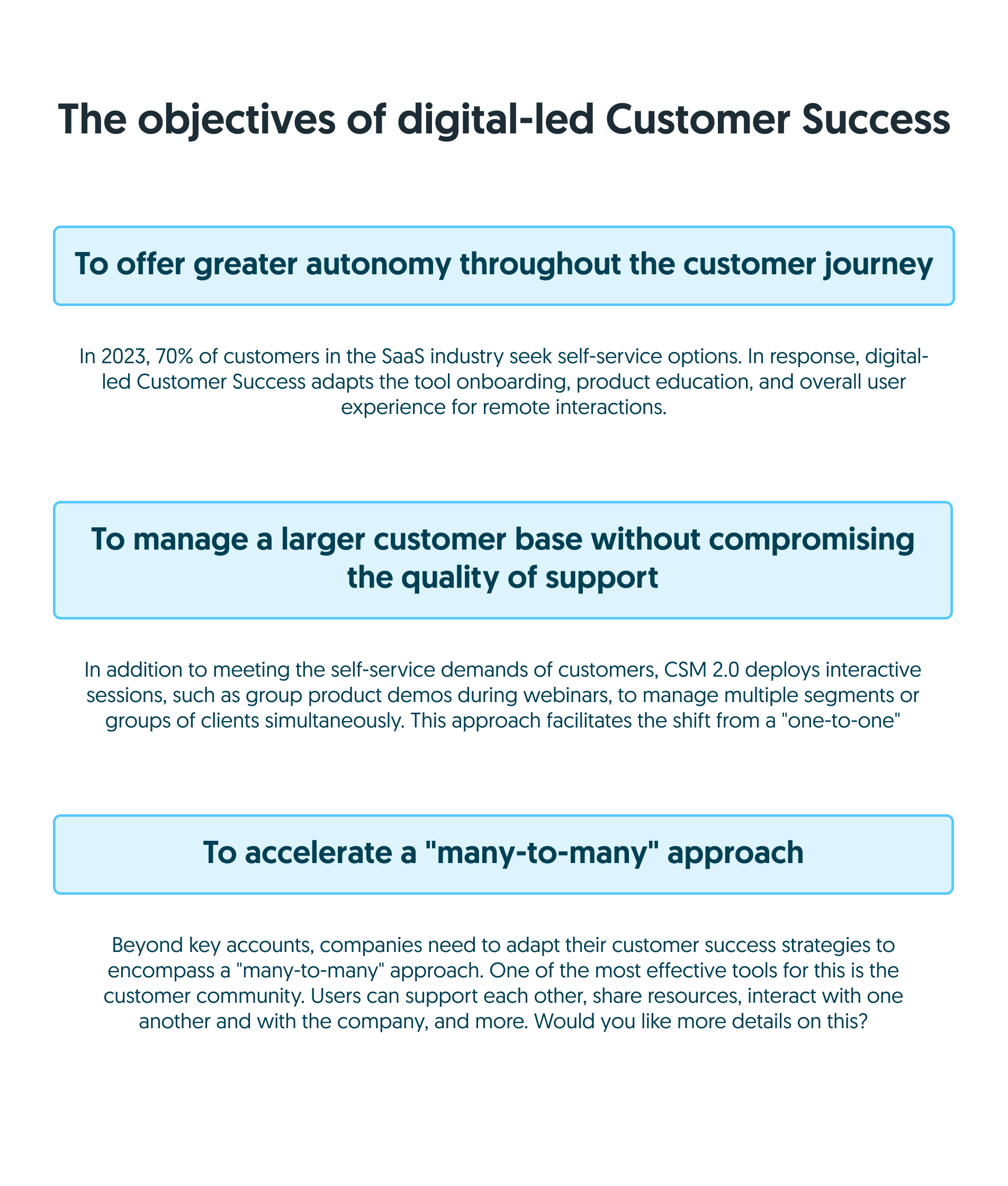For 88% of customers, the customer experience is as important as the products or services (Salesforce, 2022).
So, to satisfy customers and provide unforgettable experiences, businesses prioritize defining, structuring, and delivering an impeccable Customer Success strategy, particularly in the digital era.
This mission is entrusted to Customer Success Managers. For these increasingly connected CSMs, the stakes are high. According to McKinsey, up to 50% of a company's growth relies on Customer Success. So, how can we combine customer success and a digital-led strategy to support growth? What levers should be used on a daily basis? Antonin Bigot, CSM and founder of Customerz (a collective of Customer Success experts), shares his insights. Let's dive in!
- Customer Success Manager: A Thriving Profession?
- Being a CSM in 2023: Challenges in the Digital Era
- Towards the rise of digital-led customer success?
- Peer learning: a powerful lever for digital-led Customer Success.
Customer Success Manager: A Thriving Profession?
CSM, a three-letter acronym representing a profession on the rise. Customer Success Management serves as the cornerstone of ensuring an exceptional customer experience, also known as "customer success." The dedicated efforts to provide value to customers are at the core of a Customer Success Manager's role.
To fulfil this mission, today's CSMs often take on multiple roles. Customer Success Management covers the entire customer journey, from pre-sales to post-sales, including client onboarding, renewal, product or service education, customer support, upselling, and more. However, with the passage of time, the profession tends to specialize, particularly in the digital era. This has led to the emergence of CSM 2.0, commonly referred to as "Digital Customer Success Managers."
Being a CSM in 2023: Challenges in the Digital Era
As we've witnessed, Customer Success is undergoing a profound transformation. More and more companies are prioritizing this strategy, with 72% of businesses considering it an absolute priority, according to Forrester Research.
However, this priority comes with its fair share of challenges:
"There's a genuine need for innovation, which presents both opportunities and challenges. The pace of digital transformation is relentless, and as a result, CSMs must stay constantly vigilant and adapt to change. Since there are no universally defined training or best practices for Customer Success, it falls upon us to stay attentive to evolving trends and shape the profession accordingly." - Antonin BIGOT, CSM and founder of Customerz.
Shaping the profession in the face of digitalization takes on different forms. Here are a few notable examples:
- Adopting customer-centric tools: To effectively define, structure, and deploy a Customer Success strategy, CSMs require powerful tools. Ticketing systems, organizational platforms, have become integral to the daily routines of CSM 2.0.
- Developing new customer success models: Two distinct approaches have emerged - "high touch" and "low touch." In a high-touch CSM strategy, companies prioritize personal relationships, face-to-face interactions, and one-on-one exchanges. However, in the digital age, the low-touch CSM strategy has gained momentum. It emphasizes automation, customer autonomy, and "one-to-many" relationships.
Towards the rise of digital-led customer success?
We are facing two flourishing paradigms. On one hand, the omnipresence of digital in the business and consumer landscape, fostering autonomy and self-service. On the other hand, the importance of placing the customer at the heart of strategies to enhance end-to-end satisfaction.
To address these challenges, a new trend emerges a specialization in the field known as "digital-led Customer Success."
The objectives of digital-led Customer Success are:

Peer learning: a powerful lever for digital-led Customer Success.
In many organizations, Digital-led Customer Success still means publishing a few tutorials on a help center or uploading documentation into a traditional LMS. But that’s no longer enough.
To truly scale product adoption, companies are moving toward more dynamic formats, ones that encourage knowledge sharing, user feedback, and best practice exchange across the customer base. By creating spaces where users can learn from each other, share what works, and exchange insights, businesses enable:
- Faster onboarding and activation
- Reduced reliance on support
- Deeper product engagement
This kind of peer learning not only accelerates adoption but builds lasting trust with users, a cornerstone of any scalable Customer Success strategy.
So, is peer-driven collaboration one of the keys to a successful Digital-led Customer Success strategy? At MeltingSpot, we believe it’s an essential lever, especially when combined with structured, in-app training and asynchronous learning experiences.
When users are empowered to share insights, learn from one another, and explore best practices in real time or asynchronously, they move faster, become more autonomous, and gain more value from the product.To activate this dynamic, Antonin Bigot highlights a few best practices:
- Develop facilitation skills: Creating an environment where users engage and share experiences requires more than providing static resources. CSMs need to curate relevant content, encourage interaction, and identify users who can support others — much like internal ambassadors.
- Balance digital scale with human connection: A digital-led strategy doesn’t mean removing all human touchpoints. On the contrary, blending asynchronous resources with live experiences (webinars, interactive sessions, or onboarding calls) helps build lasting trust.
- Align cross-functional teams: Driving adoption at scale is not the sole responsibility of Customer Success. Product, Sales, and Marketing must all contribute to this shared effort, ensuring consistency in messaging, training, and customer experience.
Become an expert in software training & adoption with MS Nation the MeltingSpot Community
Step into MS Nation, our Community, your ultimate training hub for mastering software adoption and user success!
Join MS Nation







.svg)

 Perplexity
Perplexity
 Claude
Claude
 Mistral
Mistral
 Gemini
Gemini
 Grok
Grok



.svg)
